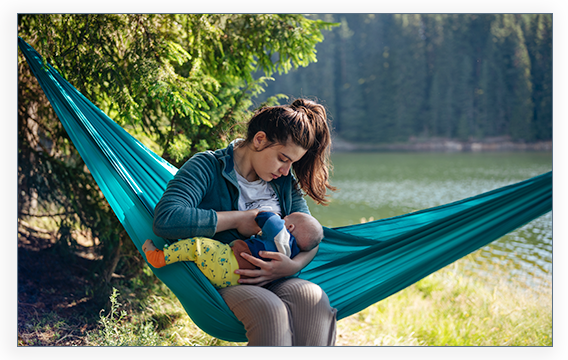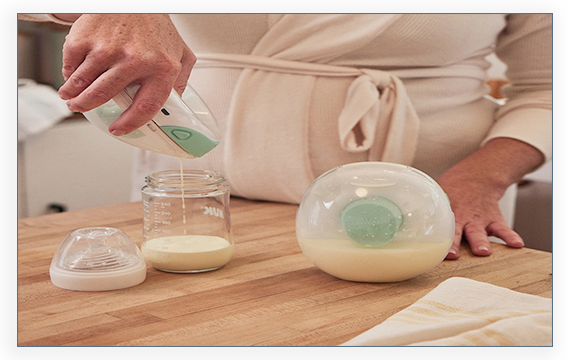Breastfeeding Troubleshooting
Although breastfeeding is natural, it can be difficult. From sore nipples and engorgement to clogged ducts, here are some of the most common breastfeeding issues and how to cope.

Sore nipples
In the first three to five days after birth, if you experience nipple soreness beyond a slight tenderness when your baby latches on, it may be a sign that something isn’t right with baby’s latch, position, or suck. Working on improving baby’s latch or position should resolve much of the pain related to sore nipples.
HOW TO HELP
Aside from correcting any issues with the latch or positioning, try the following tips:
• Vary nursing positions by trying the cradle hold, cross cradle hold, football (clutch) hold, and lying down. This helps to vary the baby’s position on the nipple over the course of the day.
• Begin the feeding on the least sore side until the letdown occurs, then gently switch baby to the other breast.
• Express a little milk or colostrum onto your nipples after nursing or use a nipple cream to help keep your nipples from becoming dry and/or cracked.
• Let your nipples air dry.
• Apply a cool compress to dry nipples after feeding.
• If your nipples are very sore, place breast shields inside your bra to prevent contact between clothes and nipples.
• If nipple pain worsens after the first days of breastfeeding, it could be due to other causes like thrush, bacterial infection, or tongue-tie.
Clogged ducts
This feels like a firm, sore lump in the breast, and may be reddened and warm to the touch. This is common and can be caused by anything from missing feedings to wearing a bra that is too tight.
HOW TO HELP
Prior to a feeding, use a warm, moist compress on the plugged area for several minutes, then massage the blocked area toward the nipple during nursing or pumping. Begin nursing or pumping on the affected side until the blockage is broken up. You can also try a warm soak in the bath or shower along with massaging the plugged duct while soaking.
Engorgement
This is a common issue new mothers experience. The symptoms may include tender or hard breasts, swelling, reddened areas, and flattened nipples from breast stretching. It may be more difficult for baby to latch if you are engorged. To help prevent engorgement, feed or pump often (usually at least 8-10 times in a 24-hour period) with a proper latch. You may need to express milk from your breasts after feeding if baby has not completely relieved the fullness.
HOW TO HELP
Discomfort may subside in as little as 24 – 48 hours by trying the following:
• Continue to breastfeed or pump frequently to relieve fullness.
• If baby is having difficulty latching properly due to the fullness, hand express or pump some milk until the areola has softened enough for baby to latch.
• Applying a warm, wet compress and massaging breasts for approximately 10 minutes before a feeding can help with milk flow, while applying a cold compress for 15 minutes each hour between feedings can help with pain and swelling.
• Rest, rest, and more rest!
Have more questions? Listen to our FREE podcast!
LISTEN NOWMastitis
Mastitis is a breast infection that typically presents itself as a painful, hard, red area on the breast, along with a fever and flu-like symptoms. It can also often follow engorgement. Cracked nipples may increase your risk, as broken skin allows germs to penetrate the breast and can lead to infection of the breast tissue. Seek medical treatment from your healthcare provider immediately if you are experiencing symptoms of mastitis.
HOW TO HELP
In addition to treatment from your healthcare provider, it is recommended to:
• Heat, rest, and empty breast.
• Use a warm compress before a feeding.
• Get extra rest.
• Continue pumping or breastfeeding; emptying the breast reduces inflammation. If this hurts, detach baby and try again.
Thrush
Thrush is caused by a yeast fungus, and symptoms can include:
• Itchy or burning nipples that appear fiery red, shiny, flaky, and/or have a rash with tiny blisters
• Cracked nipples
• Shooting pains in the breast during or after feedings
• Intense nipple or breast pain that does not improve with better latch-on and/or positioning
HOW TO HELP
It is important to see your healthcare provider for treatment, and it is necessary for both you and your baby to be treated since it is contagious and spreads easily. This fungus thrives in warm, moist environments, such as your baby’s mouth. A baby may also have yeast rashes in the diaper area.
Forceful letdown
This can be a sign of waiting too long between feedings. The more milk that is stored in the breast, the more pressure there is, making letdown more forceful.
HOW TO HELP
To manage a forceful letdown, you can press on the breast near the nipple just before latching your baby, and spray the initial streams into a cloth, bottle, cup, etc. Trying different positions such as laid back or side lying may also help slow things down.
The information contained here within is not intended to be a substitute for professional medical advice, diagnosis, or treatment. Always seek the advice of your physician or other qualified health provider with any questions you may have regarding a medical condition. Never disregard professional medical advice or delay in seeking it because of something you have read. If you think you may have a medical emergency, call your doctor, go to the emergency department, or call 911 immediately. Edwards Health Care Services (EHCS) does not recommend or endorse any specific tests, physicians, products, procedures, opinions, or other information that may be mentioned here within. Reliance on any information provided by EHCS, EHCS employees, contracted writers, or medical professionals presenting content for publication here within is solely at your own risk.
Sources:
• http://www.medelabreastfeedingus.com/article/153/managing-blocked-milk-ducts-and-treating-mastitis
• http://www.medelabreastfeedingus.com/article/88/comfort-for-mom:-treating-engorged-breasts
• https://www.llli.org/breastfeeding-info/positioning/
• https://www.mottchildren.org/health-library/hw103462
• https://americanpregnancy.org/breastfeeding/nipple-pain-remedies/
• https://www.llli.org/breastfeeding-info/thrush/
• https://www.aap.org/en-us/about-the-aap/aap-press-room/aap-press-room-media-center/Pages/Falling-Asleep-at-the-Breast-Bottle.aspx
• https://www.todaysparent.com/baby/breastfeeding/falling-asleep-at-the-breast/
• https://www.medelabreastfeedingus.com/article/141/4-reasons-babies-bite-while-breastfeeding
• https://www.llli.org/breastfeeding-info/biting/
• https://www.todaysparent.com/baby/breastfeeding/how-to-handle-oversupply-and-overactive-letdown/
Tags: Baby, Breastfeeding, Clogged ducts, Engorgement, Feeding, Infant, Letdown, Mastitis, Mom, Newborn, Sore nipples, Thrush




